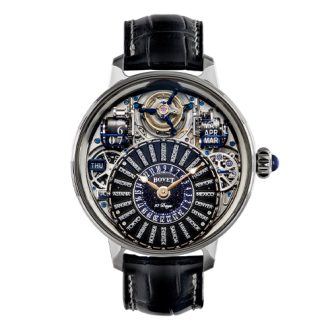Throughout the course of watchmaking history, breakthroughs have been made to solve specific problems. For example, the tourbillon was invented to counter the effects of gravity on precision when a pocket timepiece stays in one position (on a table, in a pocket, etc.).
Once world travel became increasingly popular, dual time and world time watches were developed so travelers could know what time it was in different parts of the world.
Now, with the Récital 28 “Prowess 1,” BOVET addresses a uniquely modern timekeeping issue, and solves it in an innovative and elegant way.
The Problem: Ever since Daylight Saving Time (DST) was introduced, world time watches have not been able to adapt to the vagaries of when DST starts and ends in different countries and which countries do not change (only about 70 countries use some form of DST).
The Solution: The Récital 28 Prowess 1 from BOVET, thanks to an ingenious roller system, can be adjusted to any one of the 24 times zones in:
UTC – Coordinated Universal Time
AST - American Summer Time
EAS - Europe and America Summer Time
EWT - European Winter Time
In addition to this remarkable way of managing time zone differentiation around the world, this timepiece also features an expanded flying tourbillon, a perpetual calendar with indications using rollers and a disk, and 10 days of power reserve from a single barrel.
There is no other timepiece in the world that does all of this mechanically, and every component is hand- finished and the bridges of the movement are all hand-decorated and hand-engraved.

A Little History
Mankind has been trying to master timekeeping since the beginning of time, starting with sundials, water clocks, incense clocks, and more.
Flash forward to the 1800s, when BOVET was first founded. Then, the world was in chaos regarding timekeeping. Cities, towns, and villages all operated on “local solar time,” independent of any other city. Noon on the clock was when the sun hit its zenith wherever you were – but that moment changed with your longitude. So, when it was noon in New York, City, it was 12:12 pm in Boston, Massachusetts; 11:30 am in Cleveland, Ohio; and 11:14 am in Indianapolis, Indiana. In a metropolis like New York, local time could vary as much as a minute or more between the east and the west sides of the city. Sun time even differed by about 30 seconds between the two ends of the San Francisco–Oakland Bridge.
As you can imagine, as travel sped up thanks to the railroads, matching up the times of the trains was a logistical nightmare.
Thanks to the railroads, standard time was introduced and used throughout the railway system, and in 1884, the system of 24 time zones was adopted and used throughout the world, based on the Prime Meridian in Greenwich, UK.
The US government officially adopted standard time on March 19, 1918, though it had been used throughout the country for many years. Within a decade, most of the world was keeping time by this system. In 1972, the majority of the world adopted Coordinated Universal Time (UTC) and now official time zones are indicated by +/- UTC, rather than by GMT.

Enter Daylight Saving Time (DST)
DST was first introduced during World War I, then was reinstituted again during World War II, in order to save energy and have more daylight. Countries around the world variously adopted or ignored DST -- countries nearer to the equator, for example, do not use DST, as the sunrise and sunset times don’t vary very much at all.
Today, things are no better. Countries like China, the UAE, and India do not use DST. Even in the USA, Hawaii and Arizona do not use DST, though the Navajo Nation in Arizona does. In addition, DST and the dates of the time change vary, which makes it difficult to determine what time it is anywhere in the world during a few weeks of the year.
There has recently been much talk about doing away with the time change altogether, either adopting standard time or DST for the whole year, though it will again come down to the decisions of individual countries.

The Genesis
Dating from the acquisition of BOVET in 2001, owner Mr. Raffy has always had his thoughts on the heavens and how to best interpret the various ways of telling time. In the past, he has including celestial sky charts, Equation of Time, Sidereal Time, and Summer and Winter equinoxes, just to name a few.
Ground-breaking timepieces have included:
- The Récital 18 Rising Star
- The Récital 20 Astérium (winner of the 2023 GPHG Astronomy and Calendar prize)
- The Récital 22 Grand Récital (winner of the highest GPHG honor in 2018)
- The Récital 26 Chapter Two (winner of the GPHG Mechanical Exception prize in 2020)
Now, with the Récital 28 Prowess 1, Mr. Raffy and his team have taken terrestrial time further than ever before.
“When the Récital 26 Brainstorm Chapter Two was in development, I said to myself that one of the key things that I would love to have on my wrist is an exceptional universal time timepiece that could be adjusted for the vagaries of world time,” Mr. Raffy explains. “Every year between summer time and winter time, there are weeks that don't match up, and countries that only use one time all year round. In the Récital 28 Prowess 1, the 24 time zones are on rollers at six pm and the sun (the tourbillon) is at 12. With a push of the crown, you can adjust to the four different times. It is an absolute Prowess 1 and thanks go to my team for the five years of hard work that went into this exceptional timepiece."
“In June 2022 everything was ready to go into production and I stopped the project because I did not yet have the idea to rotate the cylinders,” he continues. “The concept then was to have a world time system like the one on the Orbis Mundi, but at BOVET we always need to push watchmaking forward. We all thought the work was done, but I challenged my amazing team of engineers and watchmakers and they rose to the occasion -- the result is truly a mechanical masterpiece.”
The entire development process for the Récital 28 Prowess 1 took more than five years, with the research and development starting while BOVET was in the middle of the complicated and time-consuming Rolls- Royce Boat Tail project.

Timepiece Details
The World Time system: The 24 rollers each have four positions, all controlled through the crown – UTC, AST (American Summer Time), EAS (Europe and America Summer Time), and EWT (European Winter Time). Pushing the crown rotates each individual cylinder 90 degrees, so every time zone can be individually set. The date roller is based on a design by Leonardo da Vinci. This was chosen because the technical department needed a solution where the gearing wasn’t too tight. With this system, once the roller gets into position in its aperture, it is held in place by its spring, and the roller is freed from the gearing.
The Tourbillon: The movement powering the Récital 28 Prowess 1 is brand new, using BOVET’s patented double-sided flying tourbillon as a base. The tourbillon has been expanded - the escapement is completely on one side of the center fixation point, with the cage carrying the balance wheel and BOVET’s in-house balance spring on the other side, making it even more transparent and mesmerizing than before. The redesigned cage is the lightest BOVET has ever used, as well (62 components, with 39 being completely new), with a total weight of 0.35 grams). The Récital 28 Prowess 1 is housed in a brand- new size for BOVET’s trademarked Writing Desk case (46.30mm) to allow the tourbillon, which is in the 12 o’clock position, enough space at the widest part of the case.

The Perpetual Calendar: The date, leap year indication, and the month are on rollers, so when they get to the last day and month respectively, the date rolls back like a slot machine, with a special dampening system to stop it gently, while the other two roll forward. One more reason to stay up until midnight at the end of the month and especially at the end of the year to watch all the rollers move. On the back of the timepiece, BOVET has revealed the inner workings of the perpetual calendar mechanism for the first time ever, and it is a visual treat indeed.
The Decoration and Finishing: Each of the 744 components are hand-finished, the plate is decorated with perlage and Cotes de Geneve, and the bridges are hand-engraved as well. Of particular attention is the beveling of the major structures of the movement -- the method used is called angle rentrant. A corner is rentrant when two chamfers meet on the inside. The intersection must be clean, with a single line formed at the meeting point. This type of corner is the most difficult to produce, and the sharper the point, the more difficult it is. It requires expert hands -- at present, there is no machine capable of producing it.

Limited Production
The timepiece is in very limited production, BOVET can only handcraft a total of eight timepieces per year, as each movement takes weeks to assemble. The Récital 28 Prowess 1 comes in 18K Red Gold, 950 Platinum, and Polished Grade 5 Titanium.
“With the Récital 20 Astérium, the Récital 22 Grand Récital, and the Récital 26 Chapter Two, we focused on combining the heavens and the Earth,” Mr. Raffy details. “With the Récital 28 Prowess 1, we are solving the terrestrial time problem with a world timer that can be adjusted for all the variations in timekeeping around the world. With this timepiece, you will never be at a loss for what time it is anywhere in the world.”






